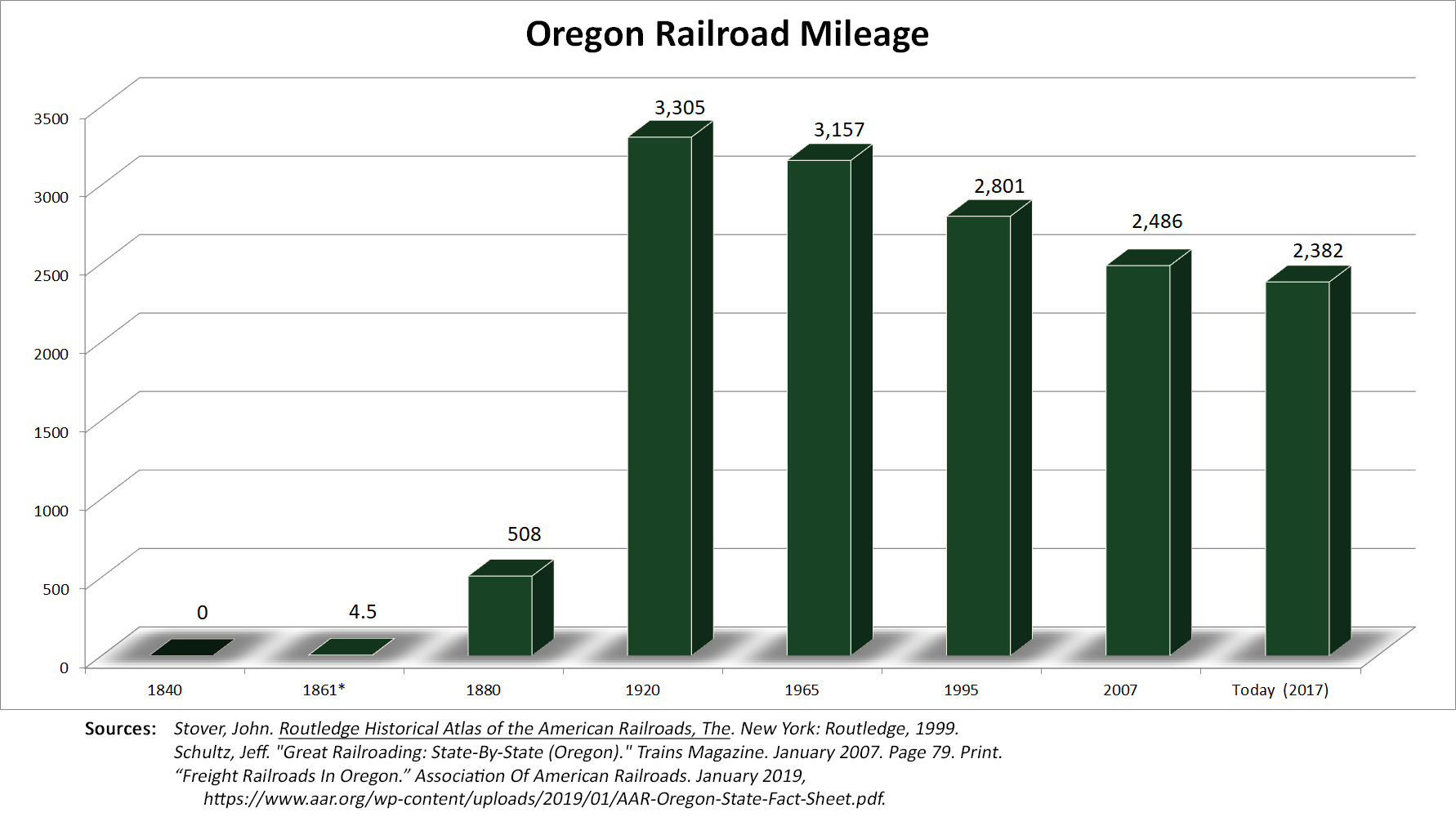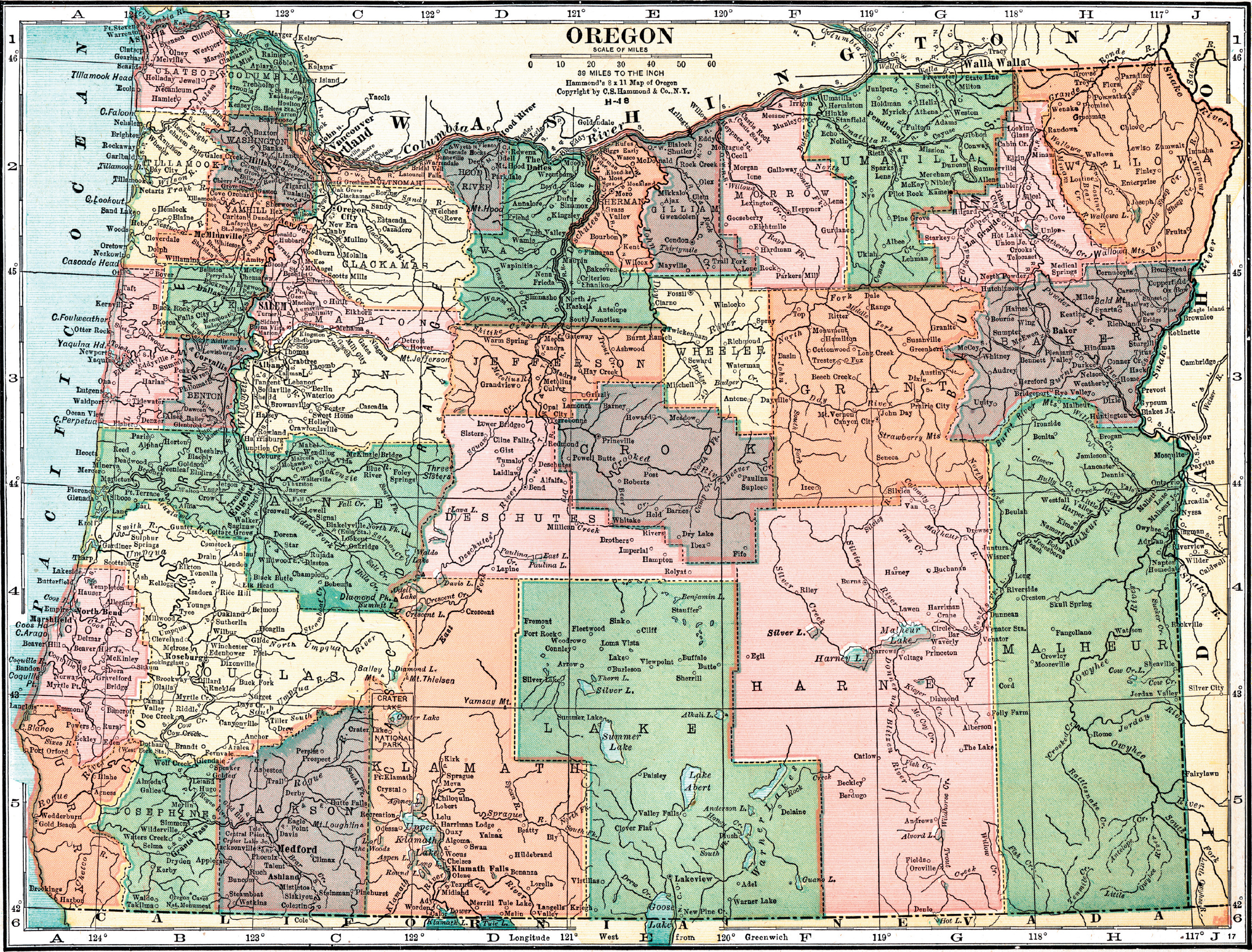- Home ›
- The States ›
- Oregon
Oregon Railroads: State Map, History, Abandoned Lines
Last revised: September 7, 2024
By: Adam Burns
Perhaps more than anything else Oregon is known for offering beautiful scenery with the Cascades,
Columbia River and of course, northern Pacific Coast all found within
the state.
Today the Beaver State is the realm of the Union Pacific, and to a lesser extent BNSF Railway. In the industry's classic era the state was served primarily by Southern Pacific (fondly remembered by railfans for its rugged branch lines tapping local timber interests and serving coastal communities) which operated the Shasta Route into Portland.
In addition to the Great Northern (snaking its way southward to reach the Western Pacific at Bieber, California, a project, the so-called 'Inside Gateway', completed in 1931) and Union Pacific.
History
Also of note was the great Oregon Electric system, an interurban linking Portland with Eugene (and controlled by the Spokane, Portland & Seattle).
Its extensive freight operations have enabled its former main line to remain in active use today, a rarity among interurbans.
In recent years short lines (and a few regionals) have also carved out a living in Oregon such as the Port of Tillamook Bay Railroad and Idaho, Northern & Pacific.
Also, please note that throughout the article here there are links included to other pages within the site that relate to Oregon railroads.
Photos
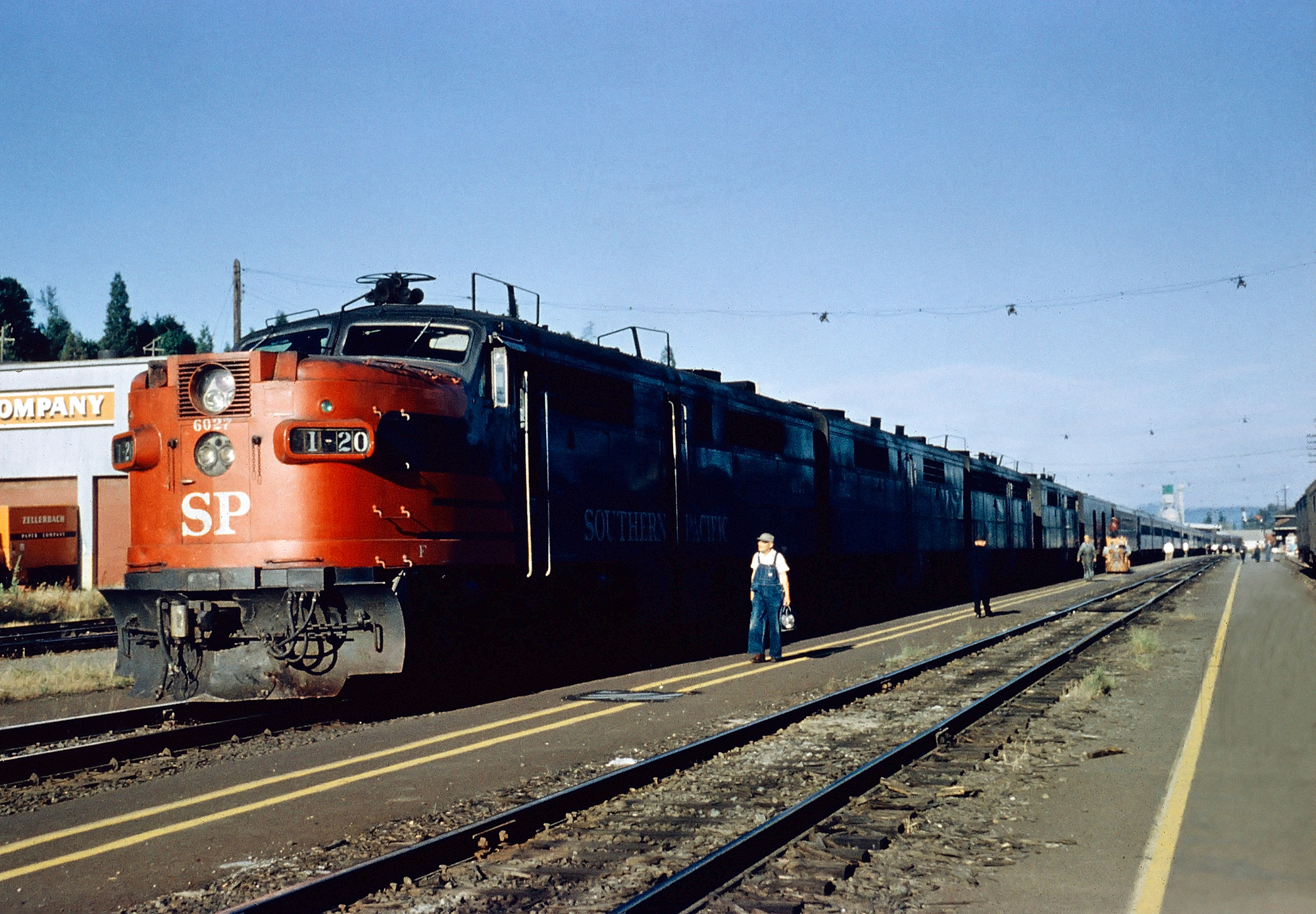 Southern Pacific PA-2 #6027 is stopped in Eugene, Oregon on the Shasta Route with northbound train #20 (Oakland - Portland), circa 1964. American-Rails.com collection.
Southern Pacific PA-2 #6027 is stopped in Eugene, Oregon on the Shasta Route with northbound train #20 (Oakland - Portland), circa 1964. American-Rails.com collection.Oregon's first railroads date back to May 20, 1861 when the small 5-mile Oregon Portage Railroad took over for mules hauling goods between Tanner Creek to the head of the Cascade Rapids (the railroad had dated as far back as 1858 using horse and mule power).
The railroad's first locomotive, the Oregon Pony was also the first steam locomotive to operate in the Pacific Northwest and today is preserved in Cascade Locks, Oregon.
The railroad eventually grew to a length of fifteen miles and its use ebbed and flowed throughout the 19th century as demand warranted.
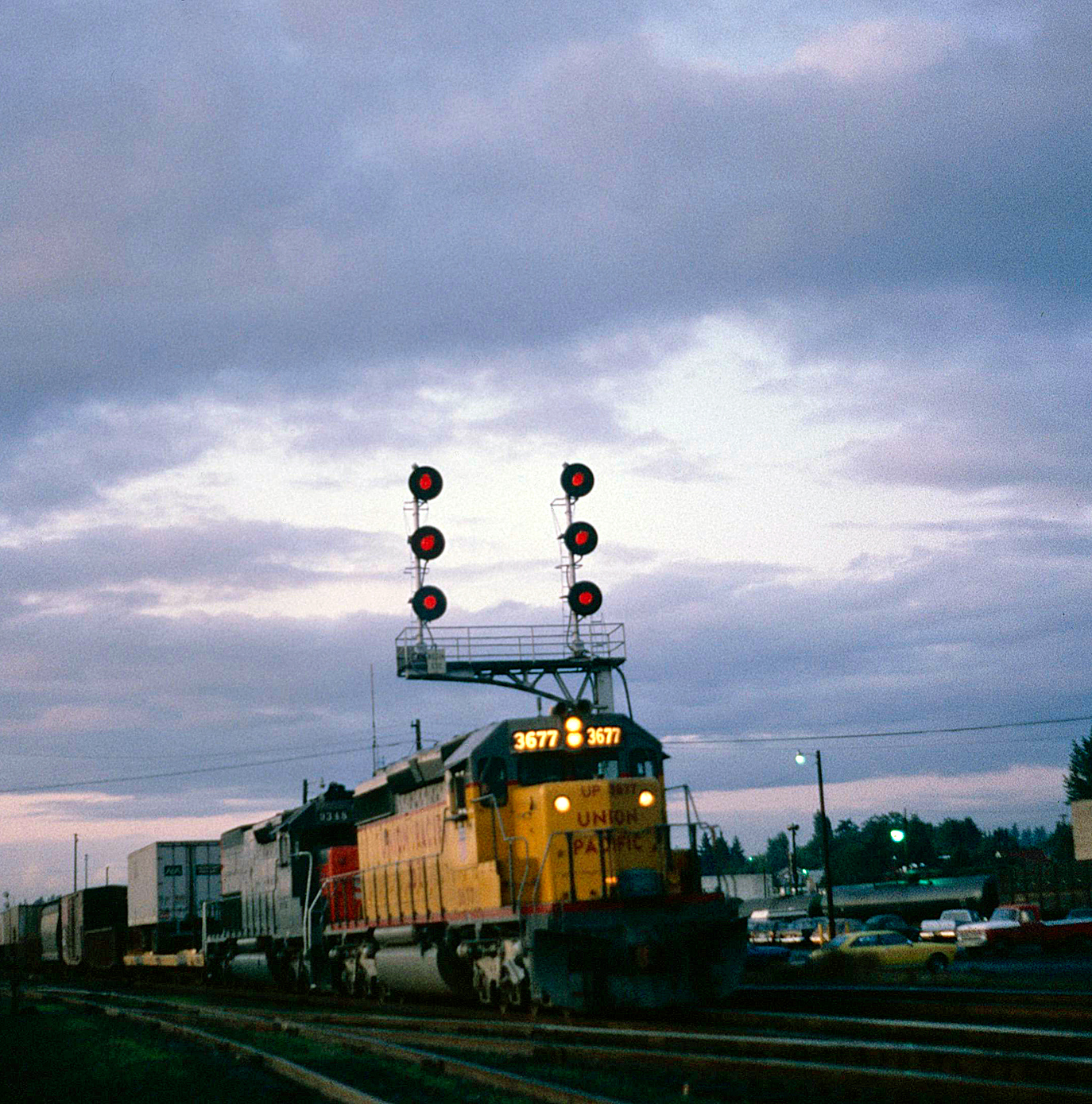 Union Pacific SD40-2 #3677 and Southern Pacific SD45T-2 #9348 depart Portland, Oregon on an October evening in 1981. American-Rails.com collection.
Union Pacific SD40-2 #3677 and Southern Pacific SD45T-2 #9348 depart Portland, Oregon on an October evening in 1981. American-Rails.com collection.In 1891 it was reactivated as a three-foot narrow-gauge operation but it would finally cease altogether in 1896.
In succeeding years following the completion of the Transcontinental Railroad in 1869, the venerable Southern Pacific would come to dominate rail operations in the state although other classic lines could also be found in Oregon.
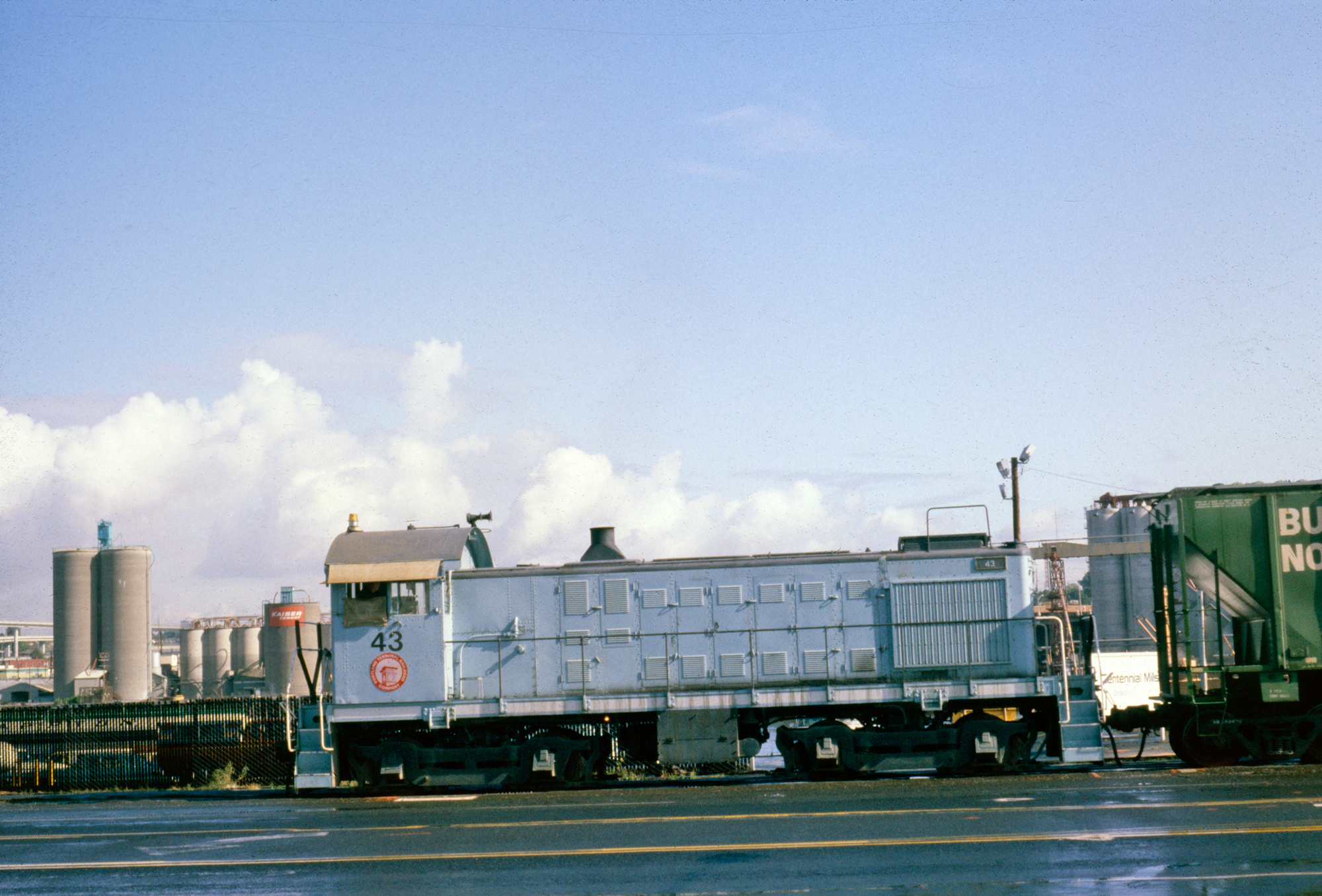 Portland Terminal Railroad (of Oregon) S4 #43 carries out switching chores at Lake Yard in Portland, Oregon during September of 1981. American-Rails.com collection.
Portland Terminal Railroad (of Oregon) S4 #43 carries out switching chores at Lake Yard in Portland, Oregon during September of 1981. American-Rails.com collection.Today, Oregon's railroad network is mostly the realm of Union Pacific although, as mentioned before, BNSF also has a small presence in the state.
Current Railroads
- BNSF Railway
- Union Pacific
- Central Oregon & Pacific
- Portland & Western
- Albany & Eastern
- City of Prineville Railway
- Clackamas Valley Railway
- Coos Bay Rail Link
- Goose Lake Railway
- Idaho, Northern & Pacific
- Klamath Northern
- Lake County Railroad
- Oregon Eastern Railroad
- Oregon Pacific Railroad
- Palouse River & Coulee City
- Peninsula Terminal Company
- Port of Tillamook Bay
- Portland Terminal Railroad
- Rogue Valley Terminal Railroad Corporation
- Wallowa Union Railroad
- Willamette Valley Railway
State Mileage Chart
First Railroad
* As Dr. George Hilton notes in his book, "American Narrow Gauge Railroads," Oregon had boasted mule-powered tramways (an early type of rail system) along the Columbia River since the 1850's. However, the earliest was destroyed by flooding in 1861.
Its first steam-powered operation was the Oregon Portage Railway, which began construction of a 4.5 mile line along the river's south bank between Tanner Creek and the Cascade Locks in 1858.
Built to a gauge of 5 feet, it was initially mule powered when it opened on May 20, 1861. That changed when the little 0-4-0 named, Oregon Pony (manufactured by the Vulcan Locomotive Works in San Francisco in 1861 at a cost of $4,000), debuted about a year later on May 10, 1862.
The Oregon Portage would go on to join Henry Villard's Oregon Railway & Navigation Company (OR&N), which later became part of Union Pacific's vast network. The OR&N was also Oregon's first, true main line railroad, enabling the Northern Pacific to initially complete its connection to the Puget Sound at Tacoma via Wallula, Oregon where the two roads connected.
Today, Oregon is home to nearly 2,500 miles of rails with its one-time high of about 3,300 miles occurring during the 1920s.
Interestingly, the state has only lost about 25% of its infrastructure, a remarkably low number considering most states have lost between 45% and 50%.
State Map
This can largely be explained by its rugged topography; virtually all main lines remain active, the only abandonments have been branch lines and secondary corridors.
For more information about Oregon in terms or route mileage over the years please have a look at the chart above.
Abandoned Lines
The state of Oregon has not witnessed considerable rail loss. As a mentioned above, the region's ruggedness, and routes linking key markets like Seattle and Portland with California have kept its through routes intact and in high demand.
In addition, Union Pacific continues to serve the Pacific Northwest via the Plains and Midwest (Wyoming/Kansas/Nebraska/Chicago).
Most abandonments across Oregon today are either former Southern Pacific branches along the coast (which handled primarily timber/lumber) or Oregon Short Line (Union Pacific) branches.
Also of note is Oregon's two notable interurbans; the Oregon Electric Railway (OE) and Portland Traction Company. The former grew quite substantially and served the entire northwestern region of Oregon while the latter was contained predominately to Portland.
Today, a few sections of the old OE remain active but for the most part, both systems are all gone today.
Although Union Pacific's famous City of Portland and Southern Pacific's Shasta Daylight passenger trains no longer calls to Portland Union Station Amtrak still does with its Empire Builder and Coast Starlight services (and the building has also been completely restored).
Aside from these services Amtrak operates the Cacades from Portland to Seattle four times a day with two trips daily to Eugene as well.
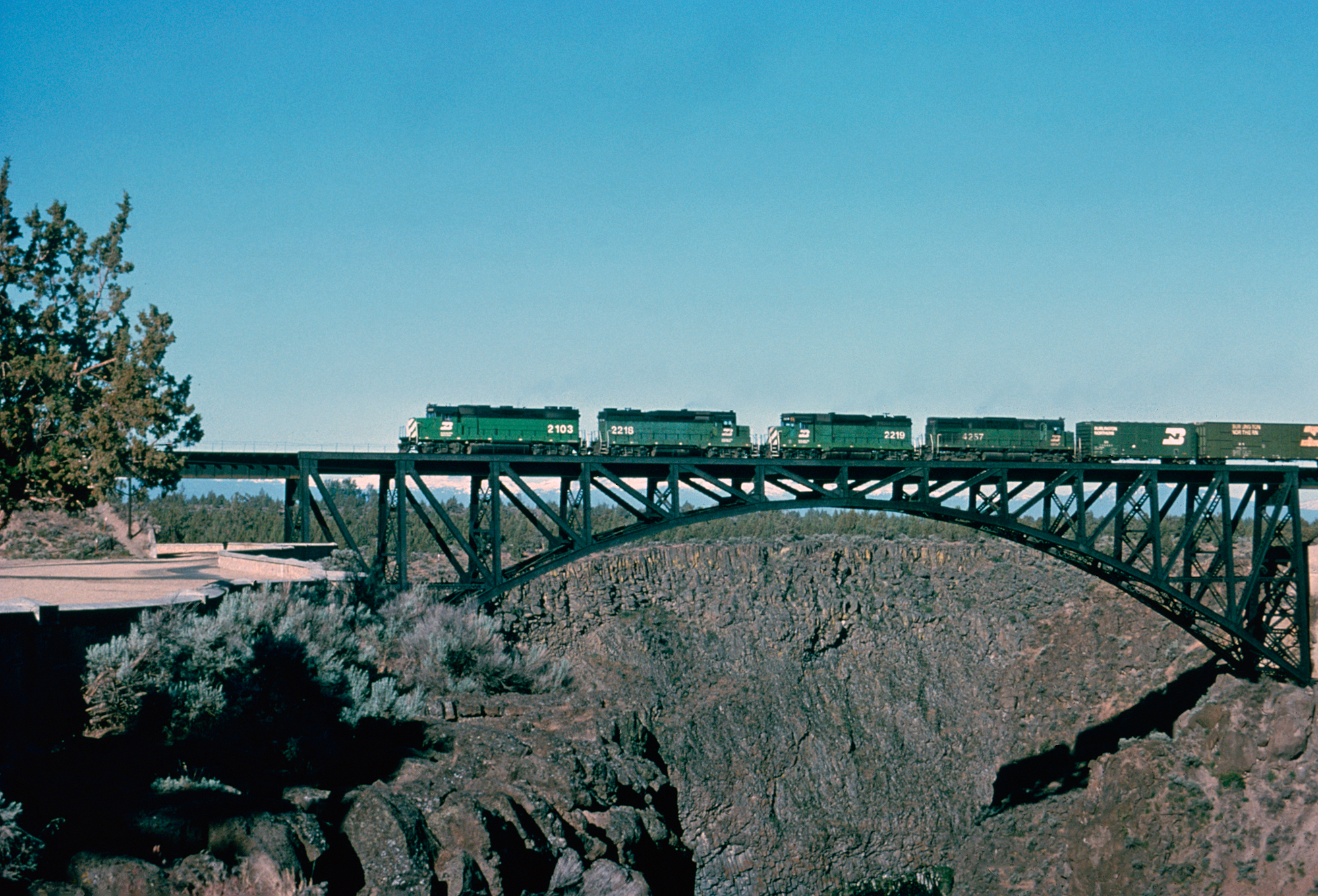 Burlington Northern GP38-2 #2103, GP30's #2216 and #2219, and C425 #4257 lead a southbound freight over the Crooked River Bridge just north of Terrebonne, Oregon during the 1970s. This was part of the Great Northern's link to Bieber, California and a connection with the Western Pacific. American-Rails.com collection.
Burlington Northern GP38-2 #2103, GP30's #2216 and #2219, and C425 #4257 lead a southbound freight over the Crooked River Bridge just north of Terrebonne, Oregon during the 1970s. This was part of the Great Northern's link to Bieber, California and a connection with the Western Pacific. American-Rails.com collection.To learn more about the classic streamliners that served Oregon please click here.
Aside from the passenger and freight trains, Oregon is home to several museums and tourist railroads such as the Oregon Electric Railway Museum and very popular Moot Hood Railroad, which features spectacular views of Mount Hood (and even includes a dinner train).
In all, Oregon railroads feature some of the most stunning
scenery one can find anywhere in the country whether you are after main
line railroading, local short line service or just a ride on a train to
enjoy views of the Oregon countryside.
Recent Articles
-
Wisconsin's Dinner Train Rides In North Freedom!
Jan 20, 26 01:55 PM
Featured here is a practical guide to Mid-Continent’s dining train concept—what the experience is like, the kinds of menus the museum has offered, and what to expect when you book. -
New York's Dinner Train Rides In The Adirondacks!
Jan 20, 26 12:41 PM
Operating over a restored segment of the former New York Central’s Adirondack Division, the Adirondack Railroad has steadily rebuilt both track and public interest in passenger rail across the region. -
Pennsylvania "Dinner Train" Rides In Boyertown!
Jan 20, 26 12:04 PM
With beautifully restored vintage equipment, carefully curated menus, and theatrical storytelling woven into each trip, the Colebrookdale Railroad offers far more than a simple meal on rails. -
New York ~ Murder Mystery ~ Dinner Train Rides
Jan 20, 26 12:03 PM
New York State, renowned for its vibrant cities and verdant countryside, offers a plethora of activities for locals and tourists alike, including murder mystery train rides! -
Pennsylvania ~ Murder Mystery ~ Dinner Train Rides
Jan 20, 26 11:48 AM
Pennsylvania, steeped in history and industrial heritage, offers a prime setting for a unique blend of dining and drama: the murder mystery dinner train ride. -
Florida Valentine's Train Rides
Jan 20, 26 11:46 AM
For couples looking for something different this Valentine’s Day, the museum’s signature romantic event is back: the Valentine Limited, returning February 14, 2026—a festive evening built around a tra… -
Connecticut Valentine's Train Rides
Jan 20, 26 11:43 AM
Operated by the Valley Railroad Company, the attraction has been welcoming visitors to the lower Connecticut River Valley for decades, preserving the feel of classic rail travel while packaging it int… -
Texas Dinner Train Rides At The TSR!
Jan 19, 26 12:30 PM
Today, TSR markets itself as a round-trip, four-hour, 25-mile journey between Palestine and Rusk—an easy day trip (or date-night centerpiece) with just the right amount of history baked in. -
Iowa's Dinner Train Rides In Boone!
Jan 19, 26 12:28 PM
If you’ve ever wished you could pair a leisurely rail journey with a proper sit-down meal—white tablecloths, big windows, and countryside rolling by—the Boone & Scenic Valley Railroad & Museum… -
Ohio Dinner Train Rides At The CVSR!
Jan 19, 26 12:27 PM
While the railroad is well known for daytime sightseeing and seasonal events, one of its most memorable offerings is its evening dining program—an experience that blends vintage passenger-car ambience… -
Missouri's Dinner Train Rides In Branson!
Jan 19, 26 12:21 PM
Nestled in the heart of the Ozarks, the Branson Scenic Railway offers one of the most distinctive rail experiences in the Midwest—pairing classic passenger railroading with sweeping mountain scenery a… -
Virginia Valentine's Train Rides
Jan 19, 26 12:15 PM
If you’ve ever wanted to slow life down to the rhythm of jointed rail—coffee in hand, wide windows framing pastureland, forests, and mountain ridges—the Virginia Scenic Railway (VSR) is built for exac… -
Maryland Valentine's Train Rides
Jan 19, 26 12:12 PM
The Western Maryland Scenic Railroad (WMSR) delivers one of the East’s most “complete” heritage-rail experiences: and also offer their popular dinner train during the Valentine's Day weekend. -
Indiana's Dinner Train Rides In Jasper!
Jan 18, 26 01:54 PM
In the rolling hills of southern Indiana, the Spirit of Jasper offers one of those rare attractions that feels equal parts throwback and treat-yourself night out: a classic excursion train paired with… -
New Mexico's Dinner Train Rides
Jan 18, 26 01:37 PM
If your heart is set on clinking glasses while the desert glows at sunset, you can absolutely do that here—just know which operator offers what, and plan accordingly. -
New Hampshire ~ Murder Mystery ~ Dinner Train Rides
Jan 18, 26 01:10 PM
The state's murder mystery trains stand out as a captivating blend of theatrical drama, exquisite dining, and scenic rail travel. -
New York Valentine's Train Rides
Jan 18, 26 12:32 PM
At its best, the Adirondack Railroad delivers exactly what railfans and casual riders alike hope for: vintage coaches, classic depots, rivers and forests right outside the window. -
Washington Valentine's Train Rides
Jan 18, 26 10:50 AM
Whether you’re a dedicated railfan chasing preserved equipment or a couple looking for a memorable night out, CCR&M offers a “small railroad, big experience” vibe—one that shines brightest on its spec… -
Colorado Valentine's Train Rides
Jan 18, 26 10:49 AM
The Royal Gorge Route Railroad is the kind of trip that feels tailor-made for railfans and casual travelers alike, including during Valentine's weekend. -
Georgia Valentine's Train Rides
Jan 18, 26 10:42 AM
f you’ve ridden the SAM Shortline, it’s easy to think of it purely as a modern-day pleasure train—vintage cars, wide South Georgia skies, and a relaxed pace that feels worlds away from interstates and… -
New Jersey ~ Murder Mystery ~ Dinner Train Rides
Jan 17, 26 01:16 PM
There are currently no murder mystery dinner trains available in New Jersey although until 2023 the Cape May Seashore Lines offered this event. Perhaps they will again soon! -
West Virginia Dinner Train Rides In Elkins!
Jan 17, 26 01:08 PM
The D&GV offers the kind of rail experience that feels purpose-built for railfans and casual travelers. -
Virginia Dinner Train Rides In Staunton!
Jan 17, 26 11:55 AM
If you’ve ever wished you could pair a classic scenic train ride with a genuinely satisfying meal—served at your table while the countryside rolls by—the Virginia Scenic Railway was built for you. -
Florida Easter Train Rides
Jan 17, 26 10:23 AM
The cold weather rarely invades Florida and the state nearly always warm and balmy early spring temperatures. Learn more about where you can find Easter-themed train rides across the Sunshine State. -
Ohio Easter Train Rides
Jan 17, 26 10:13 AM
Ohio is home to several museums and excursion trains preserving the state's rich railroading heritage. A few of these locations host Easter-themed train rides each spring. -
Massachusetts Valentine's Train Rides
Jan 17, 26 09:58 AM
The Cape Cod Central Railroad (CCCR) blends classic New England scenery with heritage equipment, narrated sightseeing, and some of the region’s best-known “rails-and-meals” experiences. -
California Valentine's Train Rides
Jan 17, 26 09:53 AM
Operating out of West Sacramento, this excursion railroad has built a calendar that blends scenery with experiences—wine pours, themed parties, dinner-and-entertainment outings, and seasonal specials… -
South Carolina Dinner Train Rides
Jan 16, 26 11:13 PM
There is only location in the Palmetto State offering a true dinner train experience can be found at the South Carolina Railroad Museum. Learn more here. -
Rhode Island Dinner Train Rides
Jan 16, 26 11:01 PM
Despite its small size, Rhode Island is home to one popular dinner train experience where guests can enjoy the breathtaking views of Aquidneck Island. -
Pennsylvania's Thomas The Train Rides
Jan 16, 26 04:13 PM
"A Day Out With Thomas” train rides offer a unique opportunity for children and their families to engage in a magical and memorable experience, setting the stage for a full day of fun and adventure. -
Illinois's Thomas The Train Rides
Jan 16, 26 02:23 PM
In Illinois, the "A Day Out With Thomas" event offers a unique chance for families to immerse themselves in the enchanting world of Thomas and friends, creating memories that last a lifetime. -
New Jersey's Thomas The Train Rides
Jan 16, 26 02:11 PM
Here's a comprehensive guide to what you can expect at Day Out With Thomas events in New Jersey. -
Texas ~ Murder Mystery ~ Dinner Train Rides
Jan 16, 26 01:54 PM
Here’s a comprehensive look into the world of murder mystery dinner trains in Texas. -
Connecticut ~ Murder Mystery ~ Dinner Train Rides
Jan 16, 26 01:26 PM
All aboard the intrigue express! One location in Connecticut typically offers a unique and thrilling experience for both locals and visitors alike, murder mystery trains. -
New Hampshire Dinner Train Rides In N. Conway!
Jan 16, 26 10:47 AM
Tucked into the heart of New Hampshire’s Mount Washington Valley, the Conway Scenic Railroad is one of New England’s most beloved heritage railways -
Oregon Dinner Train Rides Near Mt. Hood!
Jan 16, 26 10:44 AM
The Mt. Hood Railroad is the moving part of that postcard—a century-old short line that began as a working railroad. -
Maryland's - Wine Tasting - Train Rides
Jan 15, 26 02:59 PM
This article delves into the enchanting world of wine tasting train experiences in Maryland, providing a detailed exploration of their offerings, history, and allure. -
Colorado's - Wine Tasting - Train Rides
Jan 15, 26 02:46 PM
To truly savor these local flavors while soaking in the scenic beauty of Colorado, the concept of wine tasting trains has emerged, offering both locals and tourists a luxurious and immersive indulgenc… -
Iowa ~ Wine Tasting ~ Train Rides
Jan 15, 26 02:36 PM
The state not only boasts a burgeoning wine industry but also offers unique experiences such as wine by rail aboard the Boone & Scenic Valley Railroad. -
Georgia's Wine Train Rides In Cordele!
Jan 15, 26 02:26 PM
While the railroad offers a range of themed trips throughout the year, one of its most crowd-pleasing special events is the Wine & Cheese Train—a short, scenic round trip designed to feel like a t… -
Indiana ~ Murder Mystery ~ Dinner Train Rides
Jan 15, 26 02:22 PM
This piece explores the allure of murder mystery trains and why they are becoming a must-try experience for enthusiasts and casual travelers alike. -
Ohio ~ Murder Mystery ~ Dinner Train Rides
Jan 15, 26 02:10 PM
The murder mystery dinner train rides in Ohio provide an immersive experience that combines fine dining, an engaging narrative, and the beauty of Ohio's landscapes. -
Nevada Dinner Train Rides In Ely!
Jan 15, 26 02:01 PM
If you’ve ever wished you could step through a time portal into the hard-working world of a 1900s short line the Nevada Northern Railway in Ely is about as close as it gets. -
Michigan Dinner Train Rides In Owosso!
Jan 15, 26 09:46 AM
The Steam Railroading Institute is best known as the home of Pere Marquette #1225 and even occasionally hosts a dinner train! -
Arizona's - Wine Tasting - Train Rides
Jan 14, 26 02:04 PM
For those who want to experience the charm of Arizona's wine scene while embracing the romance of rail travel, wine tasting train rides offer a memorable journey through the state's picturesque landsc… -
Arkansas's - Wine Tasting - Train Rides
Jan 14, 26 01:57 PM
This article takes you through the experience of wine tasting train rides in Arkansas, highlighting their offerings, routes, and the delightful blend of history, scenery, and flavor that makes them so… -
Tennessee ~ Murder Mystery ~ Dinner Train Rides
Jan 14, 26 01:42 PM
Amidst the rolling hills and scenic landscapes of Tennessee, an exhilarating and interactive experience awaits those with a taste for mystery and intrigue. -
California ~ Murder Mystery ~ Dinner Train Rides
Jan 14, 26 01:26 PM
When it comes to experiencing the allure of crime-solving sprinkled with delicious dining, California's murder mystery dinner train rides have carved a niche for themselves among both locals and touri… -
Illinois ~ Murder Mystery ~ Dinner Train Rides
Jan 14, 26 01:13 PM
Among Illinois's scenic train rides, one of the most unique and captivating experiences is the murder mystery excursion. -
Vermont's - Murder Mystery - Dinner Train Rides
Jan 14, 26 12:57 PM
There are currently murder mystery dinner trains offered in Vermont but until recently the Champlain Valley Dinner Train offered such a trip!

